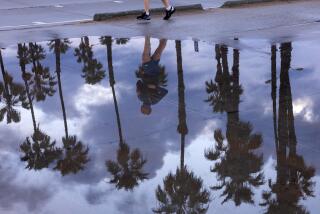L.A. is on track to set dry-weather record
As 2013 draws to a close, it is headed for the record books as the driest year in downtown Los Angeles since 1877, when official measurements began.
Only 3.60 inches have fallen at the National Weather Service station at USC since Jan. 1, about half an inch less than was recorded in 1953 and 1947, which until now had tied for the lowest rainfall.
With sun, sun and more sun in the forecast for the remaining few days of the year, meteorologists say there is virtually no chance of wet weather to undo the new record.
Statewide forecasts developed for the California Department of Water Resources suggest that dry conditions are likely to persist this winter.
Although this year’s No. 1 ranking makes for an interesting conversation piece, it has little practical effect. As anyone driving around Los Angeles can see, lawns are still green, swimming pools are full. Southland water officials aren’t sounding the alarm bells.
It has been a century since Angelenos relied primarily on local sources for their water. The city is mostly sustained by imports from other parts of California and the Colorado River. And though it has been dry all over, regional water managers say they have ample supplies in reserve.
“We’re at record storage throughout our whole system,” said Armando Acuna, head of media services for the Metropolitan Water District of Southern California, which supplies water agencies with imports from Northern California and the Colorado River.
MWD’s large reservoir in Riverside County, Diamond Valley Lake, is nearly three-quarters full. Pyramid Lake and Castaic Lake, two reservoirs in the State Water Project system that MWD draws from, are more than 90% full. The agency also has banked supplies underground and in Lake Mead on the Colorado.
As a result, MWD officials say that despite the meager precipitation, they don’t expect to ration water sales this year or next.
It was the first three months of 2013 that were largely responsible for catapulting the year to the parched top. January, February and March are typically when Los Angeles gets most of its precipitation. But last winter the rain switch never turned on.
“And this fall we haven’t been able to catch up,” said Carol Smith, a meteorologist with the National Weather Service.
Climatologist Bill Patzert of NASA’s Jet Propulsion Laboratory in La Cañada Flintridge blames a long-lasting weather pattern in the Pacific Ocean called the Pacific Decadal Oscillation.
In the cycle’s negative phase, the surface waters of the western Pacific warm while the eastern Pacific cools, rather like a big La Niña that pushes the jet stream and the storms it carries to the north of California.
The reverse ocean temperature pattern prevails when the oscillation is in the positive phase, producing wetter, El Niño-like conditions.
For more than a decade, the oscillation has tended toward the negative. “Since 1997-98 more or less, we’ve been in a dry pattern” in the West, Patzert said.
A glance at the weather service records backs that up. Of the 10 driest years recorded in downtown L.A., two — 2013 and 2007 — have occurred in the last decade.
But meteorologists look at rainfall years, which extend from July 1 through June 30. Three of the 10 driest rainfall years were recorded since 2001 — though at 5.85 inches, 2012-13 falls to the sixth-driest in downtown L.A. The driest rainfall year was 2006-07, when a mere 3.21 inches fell.
Despite the dry winter outlook, atmospheric rivers — large atmospheric bands of moisture from the Pacific — can drench the state on short notice. And the fact that neither El Niño nor La Niña is expected to develop this winter makes predictions even trickier.
Some of the wettest and driest winters in the West have occurred under those volatile “La Nada” conditions, Patzert said.
Whatever the winter brings, local officials say it’s important that Angelenos continue to conserve. The city’s per capita water use has dropped from 187 gallons a day in 1986 to 123 gallons in recent years. Overall, L.A. uses less water than it did 40 years ago, despite the addition of more than 1 million residents.
“Los Angeles has really pulled together to make conservation a priority, and we need to keep this momentum going given what may look to be the third dry year in a row,” said Jim McDaniel, senior assistant general manager at the Los Angeles Department of Water and Power.
The city’s water conservation ordinance, adopted in 2009, remains in effect. It limits outdoor watering to three days a week and bans hosing down driveways and sidewalks. The DWP is also paying homeowners $2 a square foot to tear out their lawns and replace them with drought tolerant plants or permeable hardscape.
On average, Los Angeles gets about a third of its supplies from the Owens Valley in the Eastern Sierra and buys about half from MWD. Only about 12% is local, most of it groundwater.
This winter has gotten off to a dry start in the Eastern Sierra, where the Mammoth Pass snowpack is less than 30% of normal for this time of year. If it stays low, the DWP will have to purchase more supplies from MWD.
It may be tough to forecast this winter’s precipitation, but Smith was comfortable saying the last days of 2013 will be dry, establishing a record that Los Angeles could do without.
“It’s notable,” she said. “But it’s not like we’re celebrating — ‘Come on, no more rain.’”







